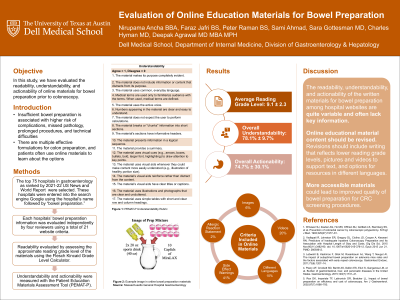Back


Poster Session A - Sunday Afternoon
Category: General Endoscopy
A0272 - Evaluation of Online Educational Materials on Hospital Websites for Bowel Preparation
Sunday, October 23, 2022
5:00 PM – 7:00 PM ET
Location: Crown Ballroom

Has Audio

Nirupama Ancha, BBA
Dell Medical School at the University of Texas at Austin, TX
Presenting Author(s)
Nirupama Ancha, BBA1, Faraz Jafri, BS2, Pralahad Raman, BS2, Sami Ahmad, 3, Sara Gottesman, MD1, Charles Hyman, MD2, Deepak Agrawal, MD, MPH, MBA2
1Dell Medical School at the University of Texas at Austin, Austin, TX; 2Dell Medical School, Austin, TX; 3University of Texas at Austin, Austin, TX
Introduction: High-quality screening colonoscopy is dependent on adequate colonoscopy preparation (prep). Despite many new formulations including low-volume laxative preps and split-prep schedules, inadequate colon preps are not uncommon. One important factor in improving the quality of colon prep is ensuring that patients understand the prep instructions. Apart from verbal communication, many hospitals post colonoscopy prep instructions on their website. In this study, we evaluated the readability, understandability, and actionability of online colonoscopy prep instructions.
Methods: The top 75 hospitals in gastroenterology as ranked by 2021-22 US News and World Report were selected. These hospitals were entered into the Google search engine using the hospital’s name followed by “bowel preparation.” Each hospitals’ bowel preparation information was evaluated independently by four reviewers using a total of 21 website criteria including readability, understandability, and actionability. Readability of each website was evaluated by assessing the approximate reading grade level of the materials using the Flesch Kincaid Grade Level Calculator with a preferred reading grade level below 6. Understandability and actionability were measured with the Patient Education Materials Assessment Tool (PEMAT) with recommended scores above 70% for both. Materials were excluded from review if no standardized document was listed on the hospital website or if duplicate materials were listed among two websites.
Results: After exclusion, a total of 51 out of 75 web pages were evaluated. Average reading grade level of the materials assessed was 9.1 ± 2.3. Overall understandability score was 78.1% ± 9.7%, and overall actionability score was 74.7% ± 30.1%. Of the websites assessed, 6% of hospitals included images to support text and 20% included videos in addition to text. 18% of the hospitals linked resources in different languages. 59% of materials did not include side effect warnings, and only one website listed an allergic reaction statement.
Discussion: The readability, understandability, and actionability of the written materials for bowel preparation among hospital websites are quite variable and do not meet the recommended standards. In addition, materials often lack key information. The educational content provided by physicians can be improved by further identifying what constitutes effective communication and using online tools to assess and improve readability and display.
Disclosures:
Nirupama Ancha, BBA1, Faraz Jafri, BS2, Pralahad Raman, BS2, Sami Ahmad, 3, Sara Gottesman, MD1, Charles Hyman, MD2, Deepak Agrawal, MD, MPH, MBA2. A0272 - Evaluation of Online Educational Materials on Hospital Websites for Bowel Preparation, ACG 2022 Annual Scientific Meeting Abstracts. Charlotte, NC: American College of Gastroenterology.
1Dell Medical School at the University of Texas at Austin, Austin, TX; 2Dell Medical School, Austin, TX; 3University of Texas at Austin, Austin, TX
Introduction: High-quality screening colonoscopy is dependent on adequate colonoscopy preparation (prep). Despite many new formulations including low-volume laxative preps and split-prep schedules, inadequate colon preps are not uncommon. One important factor in improving the quality of colon prep is ensuring that patients understand the prep instructions. Apart from verbal communication, many hospitals post colonoscopy prep instructions on their website. In this study, we evaluated the readability, understandability, and actionability of online colonoscopy prep instructions.
Methods: The top 75 hospitals in gastroenterology as ranked by 2021-22 US News and World Report were selected. These hospitals were entered into the Google search engine using the hospital’s name followed by “bowel preparation.” Each hospitals’ bowel preparation information was evaluated independently by four reviewers using a total of 21 website criteria including readability, understandability, and actionability. Readability of each website was evaluated by assessing the approximate reading grade level of the materials using the Flesch Kincaid Grade Level Calculator with a preferred reading grade level below 6. Understandability and actionability were measured with the Patient Education Materials Assessment Tool (PEMAT) with recommended scores above 70% for both. Materials were excluded from review if no standardized document was listed on the hospital website or if duplicate materials were listed among two websites.
Results: After exclusion, a total of 51 out of 75 web pages were evaluated. Average reading grade level of the materials assessed was 9.1 ± 2.3. Overall understandability score was 78.1% ± 9.7%, and overall actionability score was 74.7% ± 30.1%. Of the websites assessed, 6% of hospitals included images to support text and 20% included videos in addition to text. 18% of the hospitals linked resources in different languages. 59% of materials did not include side effect warnings, and only one website listed an allergic reaction statement.
Discussion: The readability, understandability, and actionability of the written materials for bowel preparation among hospital websites are quite variable and do not meet the recommended standards. In addition, materials often lack key information. The educational content provided by physicians can be improved by further identifying what constitutes effective communication and using online tools to assess and improve readability and display.
Disclosures:
Nirupama Ancha indicated no relevant financial relationships.
Faraz Jafri indicated no relevant financial relationships.
Pralahad Raman indicated no relevant financial relationships.
Sami Ahmad indicated no relevant financial relationships.
Sara Gottesman indicated no relevant financial relationships.
Charles Hyman indicated no relevant financial relationships.
Deepak Agrawal indicated no relevant financial relationships.
Nirupama Ancha, BBA1, Faraz Jafri, BS2, Pralahad Raman, BS2, Sami Ahmad, 3, Sara Gottesman, MD1, Charles Hyman, MD2, Deepak Agrawal, MD, MPH, MBA2. A0272 - Evaluation of Online Educational Materials on Hospital Websites for Bowel Preparation, ACG 2022 Annual Scientific Meeting Abstracts. Charlotte, NC: American College of Gastroenterology.

